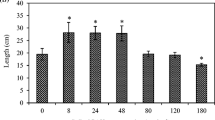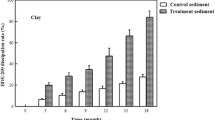Abstract
Purpose
Plant species was considered to be a significant factor influencing the efficiency of phytoremediation. Therefore, the ability of four submerged aquatic plants to facilitate the remediation of sediments polluted with polycyclic aromatic hydrocarbons (PAHs) was compared.
Materials and methods
Surface sediments (top 0–15 cm) were collected from the Haihe River, Tianjin, China, and spiked with a mixture of phenanthrene and pyrene (about 15 mg kg−1 dry sediment of each PAH). Four submerged aquatic plant species (Hydrilla verticillata, Myriophyllum verticillatum, Vallisneria spiralis, and Potamogeton crispus L.) were used for the remediation experiment. The experiment lasted for 54 days. Plant length and fresh weight, and root morphology were measured. Concentrations of phenanthrene and pyrene in plants and sediments were analyzed. Sediment redox potential and PAH-degrading bacterial population were also determined.
Results and discussion
During a 54-day experiment, more PAHs were dissipated in planted sediments than in unplanted sediments. At the end, dissipation ratios of phenanthrene and pyrene were 48.0–85.3 and 45.7–82.4 % in planted sediments but only 33.9 and 38.3 % in unplanted sediments. Dissipation ratios of the PAHs were significantly different among the four plant species and were the highest in sediments with V. spiralis. Mass balance calculation showed that plant accumulation of phenanthrene and pyrene accounted for less than 1.0 and 6.9 % of the dissipation increments, respectively. Among the plants tested, there were significantly positive correlations between PAH dissipation ratios and sediment redox potentials.
Conclusions
The results suggested that different from terrestrial plant, enhanced dissipation of PAHs by submerged aquatic plants might be mainly attributed to differences in root oxygenation capabilities. Furthermore, root oxygenation may be a useful tool in screening plants for efficient remediation of PAH-polluted sediments. Extension of these results to field-aged PAH-contaminated sediments needs further investigation.





Similar content being viewed by others
References
Allen WC, Hook PB, Biedermanc JA, Steinc OR (2002) Temperature and wetland plant species effects on wastewater treatment and root zone oxidation. J Environ Qual 31:1010–1016
Bouloubassi I, Fillaux J, Saliot A (2001) Hydrocarbons in surface sediments from the Changjiang (Yangtze River) Estuary, East China Sea. Mar Pollut Bull 42:1335–1346
Braeckevelt M, Rokadia H, Imfeld G, Stelzer N, Paschke H, Kuschk P, Kästner M, Richnow H-H, Weber S (2007) Assessment of in situ biodegradation of monochlorobenzene in contaminated groundwater treated in a constructed wetland. Environ Pollut 148:428–437
Braeckevelta M, Mirschela G, Wiessnera A, Rueckertb M, Reichec N, Vogtd C, Schultze A, Paschkee H, Kuschka P, Kaestnera M (2008) Treatment of chlorobenzene-contaminated groundwater in a pilot-scale constructed wetland. Ecol Eng 33:45–53
Casper BB, Jackson RB (1997) Plant competition underground. Annu Rev Ecol Syst 28:545–570
Cheemaa SA, Khan MI, Shen C, Tang X, Farooq M, Chena L, Zhang C, Chen Y (2010) Degradation of phenanthrene and pyrene in spiked soils by single and combined plants cultivation. J Hazard Mater 177:384–389
Chung WK, King GM (1999) Biogeochemical transformations and potential polyaromatic hydrocarbon degradation in macrofaunal burrow sediments. Aquat Micro Ecol 19:285–295
Cofield N, Banks MK, Schwab AP (2008) Lability of polycyclic aromatic hydrocarbons in the rhizosphere. Chemosphere 70:1644–1652
Farooq S, Eqani SA-M-A-S, Malik RN, Katsoyiannis A, Zhang G, Yl Z, Li J, Xiang L, Jones KC, Shinwarid ZK (2011) Occurrence, finger printing and ecological risk assessment of polycyclic aromatic hydrocarbons (PAHs) in the Chenab River, Pakistan. J Environ Monit 13:3207–3215
Fletcher JS, Hegde RS (1995) Release of phenols by perennial plant roots and their potential importance in bioremediation. Chemosphere 31:3009–3016
Gan S, Lau EV, Ng HK (2009) Remediation of soils contaminated with polycyclic aromatic hydrocarbons (PAHs). J Hazard Mater 172:532–549
Ghosh U, Gillette JS, Luthy RG (2000) Microscale location, characterization, and association of polycyclic aromatic hydrocarbons on harbor sediment particles. Environ Sci Technol 34:1729–1736
Harayama S, Kok M, Neidle EL (1992) Functional and evolutionary relationships among diverse oxygenases. Annu Rev Microbiol 46:565–601
Haritash AK, Kaushik CP (2009) Biodegradation aspects of polycyclic Aromatic hydrocarbons (PAHs): a review. J Hazard Mater 169:1–15
Havelka MM (2008) A novel dual-compartment, continuous-flow wetland microcosm to assess cis-dichloroethene removal from the rhizosphere. Environ Toxicol 10:455–471
Hojae S, Sadhana C, Doohyun R, Kally B, Thomas SM, Canada KA, Burken JG, Wood TK (2000) Rhizosphere competitiveness of trichloroethylene-degrading, poplar-colonizing recombinant bacteria. Appl Environ Microbiol 66:4673–4678
Huesemann MH, Truex MJ (1996) The role of oxygen diffusion in passive bioremediation of petroleum contaminated soils. J Hazard Mater 51:93–113
Huesemann MH, Hausmann TS, Fortman TJ, Thom RM, Cullinan V (2009) In situ phytoremediation of PAH- and PCB-contaminated marine sediments with eelgrass (Zostera marina). Ecol Eng 35:1395–1404
Johnsena AR, Wickb LY, Harmsb H (2005) Principles of microbial PAH-degradation in soil. Environ Pollut 133:71–84
Johnson LD, Ortiz M, Barnes DK, Lamb JFS (1996) Inheritance of root traits in alfalfa. Crop Sci 36:1482–1487
Jones RK, Sun WH, Tang C-S, Robert FM (2004) Phytoremediation of petroleum hydrocarbons in tropical coastal soils. Environ Sci Pollut Res 11:340–346
Kaimi E, Mukaidani T, Tamaki M (2007) Screening of twelve plant species for phytoremediation of petroleum hydrocarbon-contaminated soil. Plant Prod Sci 10:211–218
Kim YB, Park KY, Chung Y, Oh KC, Buchanan BB (2004) Phytoremediation of anthracene contaminated soils by different plant species. J Plant Biol 47:174–178
Laskov C, Horn O, Hupfer M (2006) Environmental factors regulating the radial oxygen loss from roots of Myriophyllum spicatum and Potamogeton crispus. Aquat Bot 84:333–340
Lee SH, Lee WS, Lee CH, Kimc JG (2008) Degradation of phenanthrene and pyrene in rhizosphere of grasses and legumes. Environ Pollut 153:892–898
Ling WT, Gao YZ (2004) Promoted dissipation of phenanthrene and pyrene in soils by amaranth (Amaranthus tricolor L.). Environ Geol 46:553–560
Liu H, Meng F, Tong Y, Chi J (2014) Effect of plant density on phytoremediation of polycyclic aromatic hydrocarbons contaminated sediments with Vallisneria spiralis. Ecol Eng 73:380–385
Lu M, Zeng DC, Liao Y, Tong B (2012) Distribution and characterization of organochlorine pesticides and polycyclic aromatic hydrocarbons in surface sediment from Poyang Lake, China. Sci Total Environ 433:491–497
Ma X, Havelka M (2009) Phytotoxicity of chlorinated benzenes to Typha angustifolia and Phragmites communis. Environ Toxicol 24:43–48
Ma B, He Y, Chen H, Xu J, Rengel Z (2010) Dissipation of polycyclic aromatic hydrocarbons (PAHs) in the rhizosphere: synthesis through meta-analysis. Environ Pollut 158:855–861
McNally DL, Mihelcic JR, Lueking DR (1999) Biodegradation of mixtures of polycyclic aromatic hydrocarbons under aerobic and nitrate-reducing conditions. Chemosphere 38:1313–1321
Meng F, Chi J (2015) Interactions between Potamogeton crispus L. and phenanthrene and pyrene in sediments. J Soils Sediments 15:1256–1264
Merkl N, Schultze-Kraft R, Infante C (2005) Phytoremediation in the tropics-influence of heavy crude oil on root morphological characteristics of graminoids. Environ Pollut 138:86–91
Olson PE, Castro A, Joern M, DuTeau NM, HPilon-Smits EA, Reardon KF (2007) Comparison of plant families in a greenhouse phytoremediation study on an aged polycyclic aromatic hydrocarbon-contaminated soil. J Environ Qual 36:1461–1469
Paterson S, Mackay D, Tam D, Shiu WY (1990) Uptake of organic chemicals by plants:a review of processes, correlations and models. Chemosphere 21:297–331
Perelo LW (2010) Review: in situ and bioremediation of organic pollutants in aquatic sediments. J Hazard Mater 177:81–89
Racchetti E, Bartoli M, Ribaudo C, Longhi D, Brito LEQ, Naldi M, Iacumin P, Viaroli P (2010) Short term changes in pore water chemistry in river sediments during the early colonization by Vallisneria spiralis. Hydrobiologia 652:127–137
Ramdine G, Fichet D, Louis M, Lemoine S (2012) Polycyclic aromatic hydrocarbons (PAHs) in surface sediment and oysters (Crassostrea rhizophorae) from mangrove of Guadeloupe: levels, bioavailability, and effects. Ecotoxicol Environ Saf 79:80–89
Ravindra K, Sokhi R, Van Grieken R (2008) Atmospheric polycyclic aromatic hydrocarbons: source attribution, emission factors and regulation. Atmos Environ 42:2895–2921
Rentz JA, Alvarez PJJ, Schnoor JL (2004) Repression of Pseudomonas putida phenanthrene-degrading activity by plant root extracts and exudates. Environ Pollut 6:574–583
Sarand I, Timonen S, Liisa E, Lassila N, Koivula T, Haahtela K, Romantschuk M, Sen R (1998) Microbial biofilms and catabolic plasmid harbouring degradative fluorescent pseudomonads in Scots pine mycorrhizospheres developed on petroleum contaminated soil. FEMS Microbiol Ecol 27:115–126
Singer AC, Crowley DE, Thompson IP (2003) Secondary plant metabolites in phytoremediation and biotransformation. Trends Biotechnol 21:123–130
Sprovieri M, Feo ML, Prevedello L, Manta DS (2007) Heavy metals, polycyclic aromatic hydrocarbons and polychlorinated biphenyls in surface sediments of the Naples harbour (southern Italy). Chemosphere 67:998–1009
Srivastava J, Gupta A, Chandra H (2008) Managing water quality with aquatic macrophytes. Rev Environ Sci Biotechnol 7:255–266
Sun H, Xu J, Yang S, Liu G, Dai S (2004) Plant uptake of aldicarb from contaminated soil and its enhanced degradation in the rhizosphere. Chemosphere 54:569–574
Sung K, Corapcioglu MY, Drew MC (2001) Plant contamination by organic pollutants in phytoremediation. Mar Pollut Bull 30:2081–2090
USEPA (1996) Soxhlet extraction. US Environmental Protection Agency, Washington DC, USA
Wiltse CC, Rooney WL, Chen Z, Schwab AP, Banks MK (1998) Greenhouse evaluation of agronomic and crude oil-phytoremediation potential among alfalfa genotypes. J Environ Qual 27:169–173
Yan ZS, Hong YG, Song TS, Hu Y, Jiang HL (2011) Tolerance and remedial function of rooted submersed macrophyte Vallisneria spiralis to phenanthrene in freshwater sediments. Ecol Eng 37:123–127
Yan Z, Song N, Cai H, Tay J-H, Jiang H (2012) Enhanced degradation of phenanthrene and pyrene in freshwater sediments by combined employment of sediment microbial fuel cell and amorphous ferric hydroxide. J Hazard Mater 199–200:217–225
Acknowledgments
The authors are grateful to the National Natural Science Foundation of China (contract/grant number 21377091).
Author information
Authors and Affiliations
Corresponding author
Additional information
Responsible editor: Karl J. Rockne
Rights and permissions
About this article
Cite this article
He, Y., Chi, J. Phytoremediation of sediments polluted with phenanthrene and pyrene by four submerged aquatic plants. J Soils Sediments 16, 309–317 (2016). https://doi.org/10.1007/s11368-015-1221-4
Received:
Accepted:
Published:
Issue Date:
DOI: https://doi.org/10.1007/s11368-015-1221-4




